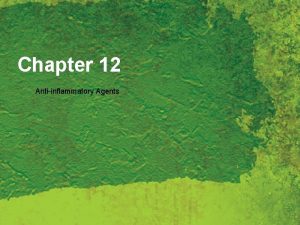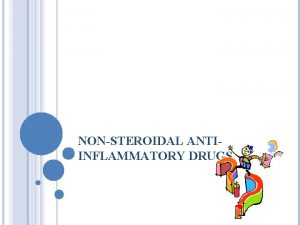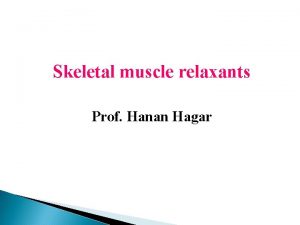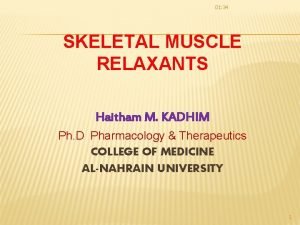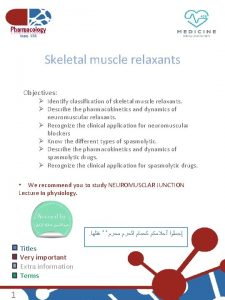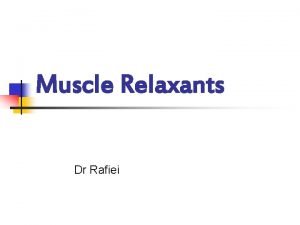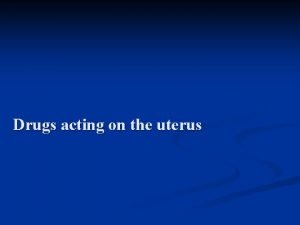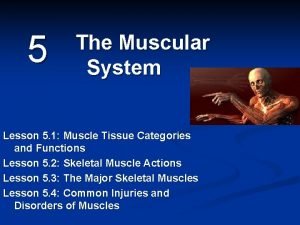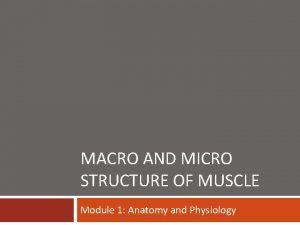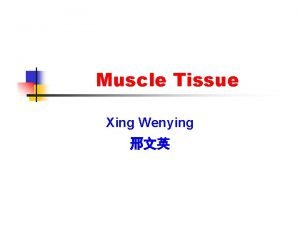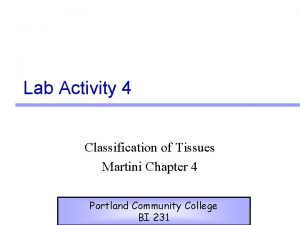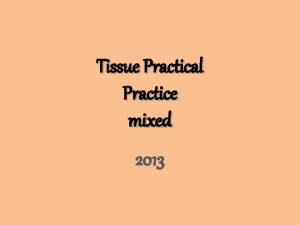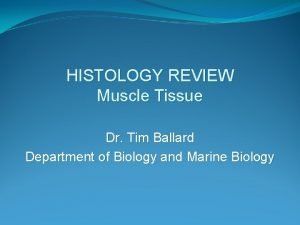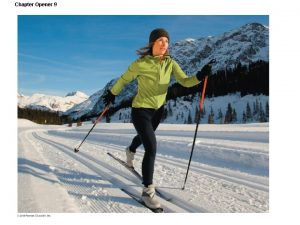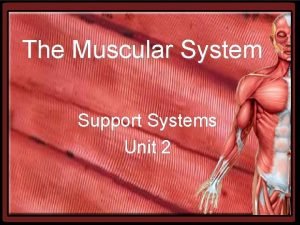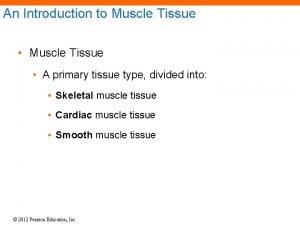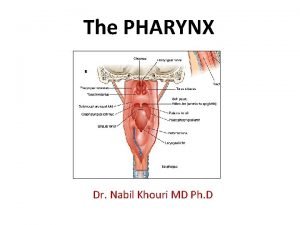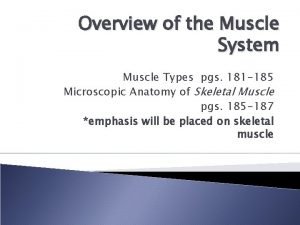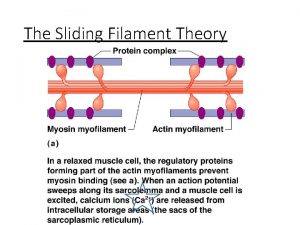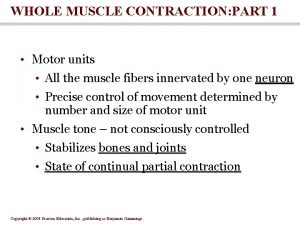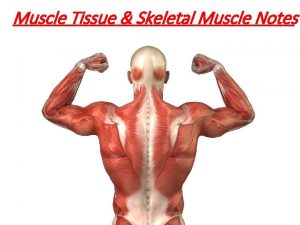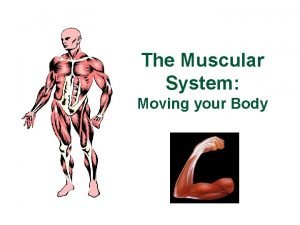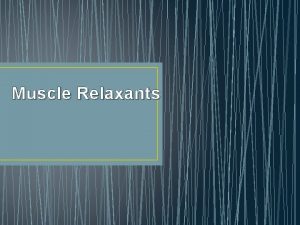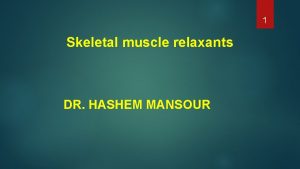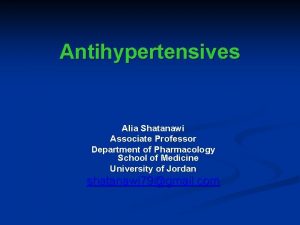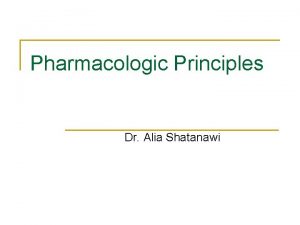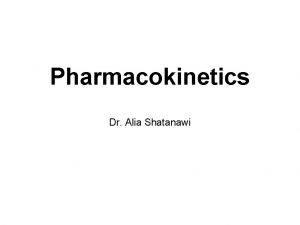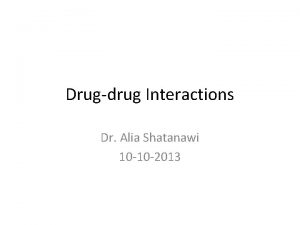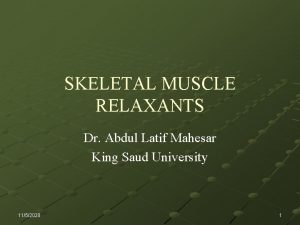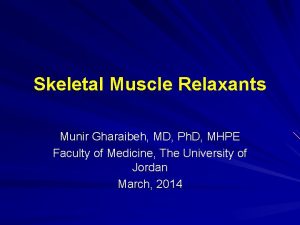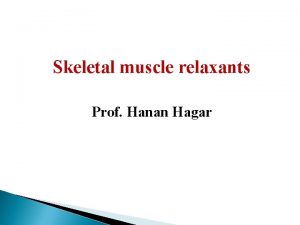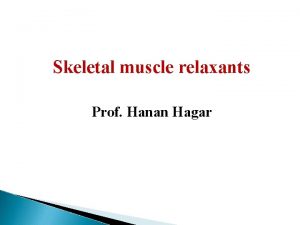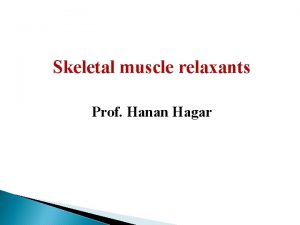Skeletal Muscle Relaxants Dr Alia Shatanawi 27 2


































- Slides: 34

Skeletal Muscle Relaxants Dr. Alia Shatanawi 27 -2 -2013




n. ACh. R: a ligand-gated ion channel Nicotinic Receptor

Skeletal Muscle Relaxants Neuromuscular Blockers: – Nondepolarizing Drugs – Depolarizing Drugs Spasmolytics. Directly Acting Drug.

Neuromuscular Blockers Chemistry: – One or two quaternary nitrogen's, i. e. poorly lipid soluble or highly polar compounds. – Double acetylcholine molecules linked: End to end: For example, succinylcholine is two acetylcholine molecules linked end-to-end Concealed bulky semi- rigid ring systems: "double-acetylcholine" structure in one of two types of bulky, semi-rigid ring systems (pancuronium)

Structures of two isoquinoline neuromuscular blocking drugs. These agents are nondepolarizing muscle relaxants

Succinylcholine, is simply two molecules of acetylcholine linked through the acetate methyl groups. Pancuronium may be viewed as two acetylcholine-like fragments oriented on a steroid nucleus.

• Structures of steroid neuromuscular blocking drugs (steroid nucleus in color). These agents are all nondepolarizing muscle relaxants

Neuromuscular Blockers Mechanism of Action – Nondepolarizing Drugs: Compete with acetylcholine at the nicotinic receptor sites at the NMJ. In high doses, can enter the pore of the ion channel to cause a more intense blockade. Can also block prejunctional sodium channels to interfere with the mobilization of acetylcholine at the nerve ending.

Neuromuscular Blockers Pharmacokinetics: – Must be given parenterally. – Nondepolarizing Drugs: Excreted in the kidney or metabolized by the liver. Mivacurium is metabolized by cholinesterases. Atracurium is spontaneously broken down (HOFFMAN ELIMINATION).



Neuromuscular Blockers Mechanism of Action: – Depolarizing Drugs: Phase I Block (depolarizing): succinycholine reacts with nicotinic receptors to opens the channel and cause depolarization of the motor end plate which will spread to adjacent membranes, causing contractions of muscle motor units. Can enter the channel to produce a prolonged “flickering” of the ion conductance. The depolarized membranes remain depolarized and unresponsive to subsequent impulses causing flaccid paralysis which is augmented by cholinesterse inhibitors.

Neuromuscular Blockers Mechanism of Action: – Depolarizing Drugs: Phase II Block( desensitizing): with continued exposure, depolarization decreases and the membrane becomes repolarized and can not be depolarized again because it is desensitized. This may be due to blockade of ion channel, which might be more important than the action of the agonist at the receptor, i. e. the channels behave as if they are in a prolonged closed state. This phase is reversed by acetylcholinesterse inhibitors.


Neuromuscular Blockers Pharmacokinetics: – Depolarizing Drugs: Extremely short duration(5 -10 minutes). (butyrylcholinesterase and pseudocholinesterase) Metabolized by cholinesterases in the plasma and liver. Only a small percentage reaches the neuromuscular junction, where it diffuse away into the extracellular fluid. Some patients have a genetically abnormal variant of plasma cholinesterase. Dibucaine Number: is a measure of the ability of a patient to metabolize succinylcholine.



Actions of Neuromuscular Blockers Skeletal Muscle Paralysis: – Nondepolarizing Drugs: Onset of effect is very rapid. Motor weakness followed by flaccidity. Starts with small muscles, large muscles are more resistant to blockade and recover more rapidly. Diaphragm is last to be paralyzed. Effects lasts for 45 -60 minutes.


Actions of Neuromuscular Blockers Skeletal Muscle Paralysis: – Nondepolarizing Drugs: – Depolarizing Drugs: Action stars by transient muscle fasiculations over the chest and abdomen within 30 seconds. Paralysis develops rapidly (within 90 seconds), the arm, neck, and leg muscles followed by the respiratory muscles. Blockade lasts less than 10 minutes.

Actions of Neuromuscular Blockers Skeletal Muscle Paralysis. Cardivascular Effects: – Mediated by autonomic or histamine receptors. – Both sympathetic and parasympathetic ganglia and muscarinic receptors in the heart can be stimulated. – Usually cause hypotension, which can be attenuated by antihistamines.

Actions of Neuromuscular Blockers Skeletal Muscle Paralysis. Cardivascular Effects. Hyperkalemia: – In patients with burns, nerve damage, or neuromuscular disease, head injury, and other trauma. – Can result in cardiac arrest.

Actions of Neuromuscular Blockers Skeletal Muscle Paralysis. Cardivascular Effects. Hyperkalemia: Increased Intraocular Pressure: – Due to tonic contraction of myofibrils or transient dilation of ocular choroidal blood vessels. Increased Intragastric Pressure: – In obese, heavily muscled, diabetics, traumatic patients, fasiculations of succinylcholine can cause regurgitation and aspiration of gastric contents. Muscle Pain: – Due to unsynchronized contractions of adjacent muscle fibers just before the onset of paralysis.

Drug Interactions of Neuromuscular Blockers Anesthetics: – Mostly with isoflurane, and least with nitrous oxide. – May be due to a central action, increased muscle blood flow. – Can cause Malignant Hyperthermia. Antibiotics: – Depress release of acetylcholine due to blockade of specific P-type of calcium channels. Local anesthetics and antiarrhythmic Drugs Other Neuromuscular Blockers.

Malignant Hyperthermia Rare heritable disorder triggered by a variety of stimuli, including general anesthetics and neuromuscular blockers. Patients have a hereditary impairment of the sarcoplasmic reticulum to sequester calcium. The trigger can causes sudden and prolonged release of calcium, with massive contraction, lactic acidosis, and increased body temperature. Treatment is by cooling, correcting acidosis, and dantrolene to reduce calcium release.

Spasmolytic Drugs Diazepam: – Acts at GABAA receptors in the CNS. – Sedative.

Spasmolytic Drugs Baclofen: – Acts at GABAB receptors, resulting in hyperpolarization and presynaptic inhibition through reducing calcium influx. – Can also reduce spasticity by inhibiting release of substance P in the spinal cord. – Less sedative, but can cause drowsiness. – Can be given intrathecally. – Can reduce craving in alcoholics and in migraine.

Spasmolytic Drugs Tizanidine: – Related to clonidine. Gabapentin: – An antiepileptic Glycine. Others


Directly Acting Drugs Dantrolene: – Related to phenytoin, an antiepileptic. – Interferes with excitation-contraction coupling in the muscle fibers by interfering with the release of activator calcium by binding with the ryanodine receptor (Ry. R) channel of the sarcoplasmic reticulum. – Can cause weakness, sedation, and hepatitis.

Botulinum Toxin Produced by Botulinum bacteria. Inhibits acetylcholine release. Food poisoning caused by this bacteria can result, within 12 -36 hours, in diplopia, dysphagia, dysarthria, and dyspnea. Toxin is use for opthalmic purposes, local muscle spasms, and in the cosmetic treatment of facial wrincles around the eyes and mouth, as well as for generalized spastic disorders like cerebral palsy.
 Alia shatanawi
Alia shatanawi Alia shatanawi
Alia shatanawi Alia shatanawi
Alia shatanawi Alia shatanawi
Alia shatanawi Non depolarizing muscle relaxant classification
Non depolarizing muscle relaxant classification Skeletal muscle relaxants classification
Skeletal muscle relaxants classification Skeletal muscle relaxants classification
Skeletal muscle relaxants classification Centrally acting skeletal muscle relaxants
Centrally acting skeletal muscle relaxants Skeletal muscle relaxants classification
Skeletal muscle relaxants classification Skeletal muscle relaxants classification
Skeletal muscle relaxants classification Dr rafiei
Dr rafiei Smooth muscle fusiform
Smooth muscle fusiform Uterine stimulants drugs
Uterine stimulants drugs Lesson 5.1 the organization of a skeletal muscle
Lesson 5.1 the organization of a skeletal muscle Contractile unit of muscle
Contractile unit of muscle Macro muscle diagram
Macro muscle diagram L
L Parallel skeletal muscle
Parallel skeletal muscle Transitional epithelium
Transitional epithelium Muscle histology review
Muscle histology review Comparison of skeletal cardiac and smooth muscle
Comparison of skeletal cardiac and smooth muscle Skeletal muscle origin
Skeletal muscle origin Hierarchy of muscle organization
Hierarchy of muscle organization I band h zone
I band h zone Pharyngo fascia
Pharyngo fascia Comparison of skeletal cardiac and smooth muscle
Comparison of skeletal cardiac and smooth muscle Somatic vs autonomic nervous system
Somatic vs autonomic nervous system 5 golden rules of skeletal muscle activity
5 golden rules of skeletal muscle activity Physiology of skeletal muscle
Physiology of skeletal muscle Nerve supply to muscles
Nerve supply to muscles Purpose of skeletal muscle
Purpose of skeletal muscle Evert foot
Evert foot Organisation of skeletal muscle
Organisation of skeletal muscle Anatomy of skeletal muscle
Anatomy of skeletal muscle Types of muscle tissue
Types of muscle tissue

